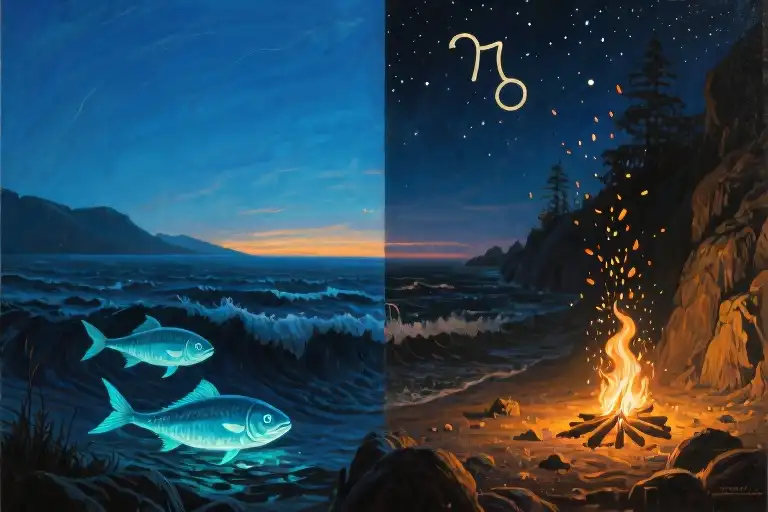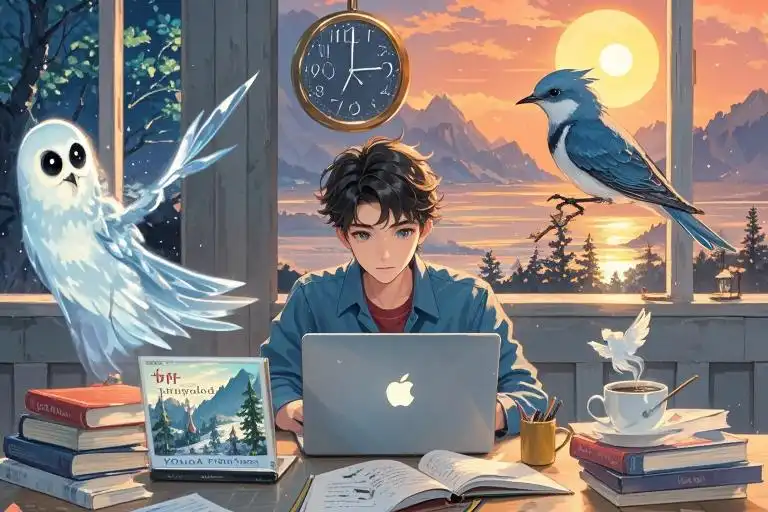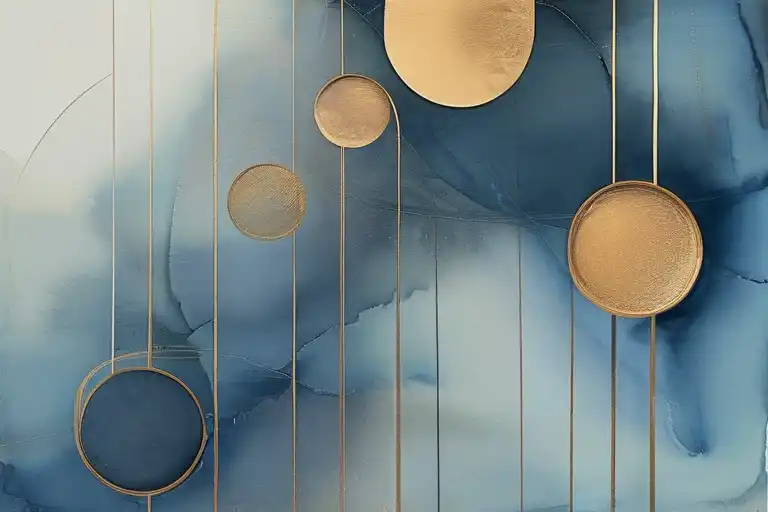My birthday falls on the cusp of Pisces and Aries – that strange twilight zone where two opposing zodiac energies collide. For as long as I can remember, I’ve lived in this gravitational pull between wanting to retreat into my deepest thoughts and craving to set the whole world on fire with my ideas. Some days I’m a deep sea dweller, content with only the most meaningful connections that reach into the marrow of existence. Other times, I transform into a surface dweller, riding the social waves with effortless joy, collecting laughter like seashells along the shore.
This constant sway between introversion and extroversion used to feel like a personality flaw. Why couldn’t I just pick a side? The pandemic isolation amplified this tension to unbearable levels. There were months when the waves of social interaction disappeared completely, leaving me stranded in a silence so profound I could hear my own heartbeat echo through empty rooms. Yet even before lockdowns began, I’d already started drifting toward isolation – not because I disliked people, but because the more I understood about our world’s complex problems, the more I questioned whether participating in society meant becoming part of its broken systems.
Perhaps you’ve felt this social isolation paradox too – that simultaneous pull toward and push away from human connection. Maybe you’re an introvert extrovert hybrid like me, or someone who’s developed social anxiety after prolonged pandemic isolation. Whatever brought you here, I want you to know this tension isn’t a failure, but an invitation to design a different kind of social life. One where we don’t have to choose between caring deeply and protecting our energy, between engaging with the world and maintaining our boundaries.
In the quietest year of my life, when I floated through days without purpose or people, I discovered something unexpected: loneliness isn’t just an absence, but a space where we can rediscover what connection truly means to us. Not the performative socializing we inherited from pre-pandemic life, not the exhausting hustle of networking, but the nourishing exchanges that make both the deep sea dweller and surface dweller parts of us feel seen. That’s what I want to explore with you – how to honor both our Piscean need for depth and Aries-like social sparks without losing ourselves in the process.
The Chameleon’s Dilemma
Living between the astrological cusp of Pisces and Aries has always felt like inhabiting two different worlds simultaneously. One moment I’m the solitary Piscean swimming in introspective depths, craving only the most meaningful connections. The next, I transform into the fiery Aries, charging headfirst into social situations with unbridled enthusiasm. This constant duality creates what I’ve come to call ‘The Chameleon’s Dilemma’ – the exhausting yet fascinating dance between two fundamentally different social needs.
The Deep Diver: My Pisces Escape to Iceland
Three years before the pandemic reshaped our collective social landscape, I found myself drawn to the isolation of Iceland’s western fjords. This became my ultimate Pisces manifestation – renting a tiny fisherman’s cottage where my only regular human contact was the elderly grocer who’d nod silently as I bought supplies every fortnight. For six months, I embraced what many would call extreme isolation, yet to me felt like coming home to my true self.
The rhythm of those days still lingers in my bones: waking to the sound of waves rather than alarms, spending hours watching arctic foxes play across the tundra, writing letters to friends I knew I wouldn’t mail for weeks. This wasn’t loneliness – it was a conscious uncoupling from social expectations that had always drained me. My social battery, perpetually depleted by the chameleon act of adapting to others, finally had space to recharge.
The Social Inferno: My Aries Party Phase
Yet this same person who thrived in Icelandic solitude had, just two years earlier, organized what campus newspapers called ‘The Party of the Semester.’ Picture this: 200 students crammed into an off-campus house, a makeshift stage for open mic performances, and enough homemade punch to fuel conversations until sunrise. Where my Piscean self needed weeks to recover from a coffee date, my Aries alter ego could work a room for hours with seemingly endless energy.
University became my laboratory for social extremes. Monday through Wednesday I’d be the quiet observer in lecture halls, taking meticulous notes and avoiding eye contact. Come Thursday, some switch would flip – I’d organize last-minute gatherings, become the designated connector introducing strangers, and stay out until security politely asked us to leave the 24-hour diner. The whiplash between these modes confused my friends as much as it confused me. ‘Are you the same person who ghosted us for three weeks last month?’ they’d tease.
The Turning Point: Climate March Epiphany
The first cracks in this exhausting duality appeared unexpectedly during the 2019 Global Climate Strike. Standing among thousands of impassioned protesters, I experienced what psychologists now call ‘crowd loneliness’ – that paradoxical isolation one can feel even in massive gatherings. As we chanted slogans about planetary unity, I realized how disconnected I felt from both the movement and my own social patterns.
Here’s the uncomfortable truth that march revealed: My Pisces-Aries pendulum wasn’t just about personality – it reflected a deeper conflict about how to engage with a troubled world. The more I learned about fast fashion’s environmental impact, the harder it became to enjoy shopping trips with friends. Understanding factory farming made casual pizza nights feel ethically complicated. My social chameleon act wasn’t sustainable because the world itself felt increasingly unsustainable.
This marked the beginning of my ‘pre-pandemic isolation’ – months before COVID-19 entered our vocabulary, I’d already started declining invitations, not because I didn’t crave connection, but because every social interaction had become emotionally expensive. The grocery store cashier’s small talk about weekend plans? Now loaded with thoughts about consumerism. A friend’s birthday dinner? Mentally calculating the carbon footprint of imported ingredients.
What began as planetary concern quietly morphed into personal paralysis. Without realizing it, I’d constructed a catch-22: To engage socially meant confronting uncomfortable truths, but avoiding those truths meant losing authentic connections. My zodiac cusp had become a metaphor for a generation’s dilemma – how to be part of systems we simultaneously want to change.
The Bridge Between Two Worlds
Understanding this pattern became my first step toward resolution. That climate march epiphany planted an important seed: Maybe the solution wasn’t choosing between my Piscean depth and Aries energy, but finding a third way that honored both. Perhaps the healthiest social life for people like us exists not at the extremes, but in the fluid space between them – what I now call ‘conscious connectivity.’
In the next chapter, we’ll explore how this isolation period intensified during the pandemic, and more importantly, how I began constructing a hybrid approach to socializing that respects both my need for deep connection and my ethical boundaries. Because here’s what I’ve learned: Our zodiac signs might suggest tendencies, but we write the final story.
Floating in the Void
March 2020. My apartment smelled of stale coffee and unopened mail. On the seventeenth silent morning, I stood barefoot on cold tiles counting birthday gifts still wrapped in their shipping boxes—three from my mother, one from an ex-colleague who didn’t know I’d quit my job. The plastic film reflected sunlight in prismatic patterns across the wall, mocking my self-imposed isolation.
I’d developed rituals to mark time. At 2:17pm daily, I’d rewatch Before Sunrise for the thirty-second time, mouthing dialogues about human connection while my laptop fan whirred like a dying insect. The fridge emitted a persistent 47-decibel hum I’d mapped across three sleepless nights. These became my social interactions: negotiations with appliances, one-sided conversations with fictional characters.
Initially, the solitude felt luxurious. As a Pisces-Aries hybrid, I’d craved this—no performative socializing, no exhausting compromises. But the tipping point came when I caught myself debating whether to wash my single plate now or ‘save it for later company.’ There was no later company. My extroverted Aries side had flatlined.
The Anatomy of Isolation
Psychologists call this social anhedonia—when human interaction stops bringing pleasure. For high-sensitivity personalities like mine, the pandemic didn’t create this void; it simply removed the background noise so I could hear my own emptiness echo. Key symptoms from my isolation diary:
- Time dilation: Mornings bled into nights without circadian markers
- Sensory distortion: Overfocus on textures (that damned fridge hum)
- Social phantom limb: Reaching for phones to share thoughts with… no one
A 2021 Journal of Abnormal Psychology study found this state particularly prevalent among introvert-extrovert ambiverts—we who constitute 38% of the population yet lack clear coping frameworks. The research used fMRI scans showing our brains literally arguing with themselves during isolation: the social-seeking Aries frontal cortex battling the Piscean parietal lobe’s withdrawal instincts.
The Worthlessness Spiral
What begins as self-protection curdles into self-erasure. By week six, I’d stopped:
- Checking emails (“No real person expects me”)
- Changing clothes (“Who’d notice?”)
- Speaking aloud (“Dry mouth proves I’m unused”)
The cruel irony? My Piscean empathy remained hyperactive. I’d weep over refugee documentaries while ignoring my own shaking hands from skipped meals. This is the high-sensitivity paradox—we absorb global suffering yet neglect our starving bodies.
A Turning Point
One April midnight, my laptop died during Ethan Hawke’s monologue about transience. In the sudden silence, I noticed my reflection in the black screen—a gaunt stranger with matted hair. That’s when the social energy theory struck me: I wasn’t antisocial; I was emotionally bankrupt. Like a cellphone perpetually on 1%, I’d stopped plugging into any charging sources.
The next morning, I performed two radical acts:
- Ate breakfast at noon (reclaiming circadian agency)
- Texted a former yoga teacher “Hi” (a 3-letter social transaction)
Neither solved systemic loneliness, but they disrupted the void’s gravity. Sometimes floating isn’t about direction—it’s remembering you still can.
Micro-action prompt: If you’re experiencing similar pandemic mental health struggles, try this now: Identify one object in your space that makes sound (clock, AC, etc.). Listen for 30 seconds. You’ve just completed your first ‘social interaction’ today—with your environment.
Why We Drift Away: The Hidden Layers of Modern Loneliness
When we talk about isolation during the pandemic, it’s easy to point fingers at lockdowns and social distancing mandates. CDC data shows face-to-face interactions dropped by 76% during peak COVID months – but what if I told you that physical separation was merely the spark, not the fuel? The roots of our disconnection run deeper than any virus.
The Surface Layer: Pandemic Isolation
Yes, empty calendars and silent Zoom calls played their part. I remember counting the tiles on my kitchen floor for the third Tuesday in a row, the hum of my refrigerator louder than my own voice. Yet even as restrictions lifted, something curious happened. Many of us (myself included) didn’t rush back to crowded bars or office happy hours. Why? Because the pandemic didn’t create our loneliness – it revealed it.
The Cognitive Avalanche: When Knowing Too Much Paralyzes Us
Here’s where social anxiety takes an existential turn. As a lifelong information seeker, I tracked climate reports like sports scores and digested human rights violations with my morning coffee. Each new fact became a brick in an invisible wall:
- Learning about fast fashion made mall trips feel unethical
- Understanding industrial farming turned dinner parties into minefields
- Seeing political polarization made small talk feel dangerous
Psychologists call this empathy fatigue – when concern for global problems overwhelms our capacity to engage locally. We start viewing every social interaction through lenses of moral consequence, until even texting “How’s your day?” feels complicit in societal denial.
The Purity Trap: When Idealism Isolates
This brings us to perhaps the most insidious layer: moral perfectionism. In my darkest isolation months, I’d concocted an unspoken rulebook:
- Any conversation not advancing social justice = wasted time
- Any activity with carbon footprint = ecological betrayal
- Any relationship requiring emotional labor = dangerous drain
What began as principled living became self-imposed exile. I’d essentially canceled myself from society before society could disappoint me – a phenomenon researchers term preemptive social withdrawal.
Evolutionary Wisdom: Loneliness as a Reset Button
But here’s the hopeful twist. Anthropologists suggest periodic isolation served our ancestors well – it allowed:
- Reassessment of tribal alliances (who truly shares your values?)
- Conservation of emotional resources (healing from conflicts)
- Development of independent survival skills
Viewed this way, my pandemic loneliness wasn’t just pathology – it was my psyche’s ancient defense mechanism screaming: “This system isn’t working for you!” The challenge became distinguishing between healthy retreat and destructive avoidance.
Your Isolation Audit: Three Revealing Questions
- Is my solitude protecting or imprisoning me? (Do you feel rested or stagnant after alone time?)
- What specific fears keep me disconnected? (Name them: “I’ll compromise my values,” “People will drain me”)
- What micro-connection could I tolerate today? (A 10-min park bench chat? A values-aligned volunteer shift?)
This isn’t about choosing between hermitage and hedonism. It’s about crafting a third way – what I call conscious connectivity. In the next section, we’ll explore practical ways to rebuild social ecosystems that honor both your boundaries and your humanity.
Key Terms Integrated: social anxiety, empathy fatigue, moral perfectionism, preemptive social withdrawal, conscious connectivity
Building a Hybrid Life
For months, I felt like a social pendulum swinging between complete isolation and overwhelming crowds. What finally anchored me was realizing socializing doesn’t have to be all-or-nothing. Here’s how I designed a hybrid system that honors both my Piscean need for depth and Aries’ spontaneous energy—without draining my social battery.
Strategy 1: The Social Energy Grading System
I started categorizing interactions like hurricane categories (A-F), based on how much preparation they required:
- A-Level (Tornado Alert): Networking events, large parties
- Prep Time: 2+ days mental preparation
- Recovery: 3-5 days alone
- My Rule: Max 1 per season
- C-Level (Breezy): Coffee with two close friends
- Prep Time: 30-minute mindset shift
- Recovery: None needed
- My Rule: Weekly staple
- F-Level (Zen Mode): Volunteering at animal shelter
- Prep Time: Just show up
- Recovery: Actually energizing
- My Rule: Unlimited (my secret weapon)
Pro Tip: Keep a running list of people/activities at each level. When someone invites you, check which category it falls into before responding.
Strategy 2: Creating Safe Social Spaces
Traditional social settings often triggered my climate anxiety—until I designed alternatives:
The Book Swap Sanctuary
Host monthly exchanges where:
- Bring 3 pre-loved books
- Zero purchase pressure (unlike bookstores)
- Conversations organically flow from shared readings
Silent Hiking Club
With fellow introverts from the shelter, we:
- Hike without small talk for first 30 minutes
- Debrief over picnic with guided questions (“What surprised you today?”)
- Part ways with no lingering social obligations
These became my social safe foods—unlikely to cause emotional indigestion.
Strategy 3: Digital Detox with Emergency Exits
Every Tuesday became my screen sabbath:
- Off Limits: All social apps, news sites
- Allowed: Email, audiobooks, creative apps
- Emergency Valve: Pre-written message for true crises:
“Doing a mental health day—can we connect tomorrow? Here’s a cat photo meantime :)”
The surprise benefit? Friends began respecting my boundaries more when they saw I wasn’t rejecting them, just protecting my energy.
The Hybrid Life in Practice
My current balance looks like:
- Mondays: F-Level shelter shift (recharges me)
- Wednesdays: C-Level coffee date
- First Fridays: B-Level book swap
- Quarterly: Single A-Level event with full recovery period
It’s not perfect—sometimes I still misjudge and crash. But now I have guardrails preventing total isolation or burnout. The key was accepting that socializing isn’t binary; there’s spectrum between hermit and social butterfly where we can all find our sustainable frequency.
Next week, I’ll share how I rebuilt my friendship ecosystem from scratch—including the exact script I used to reconnect without awkwardness.
Finding My Balance
These days, my calendar looks different than it did during those months of floating through the void. I’ve settled into a rhythm that honors both my Piscean need for depth and my Aries impulse for connection – two coffee dates per week with carefully chosen companions, and one Saturday each month volunteering at the local animal shelter where conversations flow naturally over puppy cuddles. It’s not the bustling social life of my college years, nor the hermit-like existence of my isolation phase, but something far more sustainable.
What surprised me most wasn’t finding this balance, but discovering how isolation became my greatest teacher. When you spend enough time alone with your thoughts, you start distinguishing between loneliness and solitude. The former left me feeling untethered; the latter taught me to become my own anchor. Those silent mornings when I could hear the refrigerator humming? They became laboratories for self-discovery. The days I spent rewatching the same film? They revealed which stories truly resonated with my soul.
For those still navigating this journey, here’s what I learned:
- Social energy isn’t binary – It’s a spectrum where some interactions recharge you (my shelter visits) while others drain you (large networking events)
- Small steps create momentum – That first coffee date after months alone felt terrifying, but each subsequent one became easier
- Values filter everything – Saying no to fast fashion gatherings meant making space for climate book clubs where I met kindred spirits
I’d love to hear how you’re navigating this tension between connection and self-preservation. Share your story with #SociallySelective – let’s build a community where we normalize setting boundaries without guilt.
In our next conversation, I’ll unpack practical ways to cultivate what I call “low-maintenance friendships” – the kind that nourish without depleting. Because after learning to be my own anchor, I discovered the joy of choosing which ships to let dock in my harbor.





